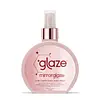What's inside
What's inside
 Key Ingredients
Key Ingredients

No key ingredients
 Benefits
Benefits

 Concerns
Concerns

No concerns
 Ingredients Side-by-side
Ingredients Side-by-side

Water
Skin ConditioningDipropylene Glycol
HumectantGlycerin
HumectantPEG-40 Hydrogenated Castor Oil
EmulsifyingPolysilicone-29
Parfum
MaskingPhenoxyethanol
PreservativeSilicone Quaternium-18
EmollientEthylhexylglycerin
Skin ConditioningBenzyl Salicylate
PerfumingTrideceth-6
EmulsifyingTrideceth-12
EmulsifyingHexyl Cinnamal
PerfumingLinalool
PerfumingLimonene
PerfumingCoumarin
PerfumingGeraniol
PerfumingCinnamyl Alcohol
PerfumingCitronellol
PerfumingEugenol
PerfumingCinnamal
PerfumingAnise Alcohol
PerfumingHelianthus Annuus Seed Oil
EmollientPanthenol
Skin ConditioningPropylene Glycol
HumectantVinegar
Cocos Nucifera Oil
MaskingLinum Usitatissimum Seed Oil
PerfumingSodium PCA
HumectantSodium Lactate
BufferingArginine
MaskingAspartic Acid
MaskingPCA
HumectantArgania Spinosa Kernel Oil
EmollientMacadamia Ternifolia Seed Oil
EmollientOlea Europaea Fruit Oil
MaskingPersea Gratissima Oil
Skin ConditioningGlycine
BufferingAlanine
MaskingSerine
MaskingPotassium Sorbate
PreservativeSodium Benzoate
MaskingUrtica Dioica Extract
AstringentValine
MaskingIsoleucine
Skin ConditioningProline
Skin ConditioningThreonine
Histidine
HumectantPhenylalanine
MaskingTocopherol
AntioxidantMalva Sylvestris Flower Extract
Skin ConditioningWater, Dipropylene Glycol, Glycerin, PEG-40 Hydrogenated Castor Oil, Polysilicone-29, Parfum, Phenoxyethanol, Silicone Quaternium-18, Ethylhexylglycerin, Benzyl Salicylate, Trideceth-6, Trideceth-12, Hexyl Cinnamal, Linalool, Limonene, Coumarin, Geraniol, Cinnamyl Alcohol, Citronellol, Eugenol, Cinnamal, Anise Alcohol, Helianthus Annuus Seed Oil, Panthenol, Propylene Glycol, Vinegar, Cocos Nucifera Oil, Linum Usitatissimum Seed Oil, Sodium PCA, Sodium Lactate, Arginine, Aspartic Acid, PCA, Argania Spinosa Kernel Oil, Macadamia Ternifolia Seed Oil, Olea Europaea Fruit Oil, Persea Gratissima Oil, Glycine, Alanine, Serine, Potassium Sorbate, Sodium Benzoate, Urtica Dioica Extract, Valine, Isoleucine, Proline, Threonine, Histidine, Phenylalanine, Tocopherol, Malva Sylvestris Flower Extract
Water
Skin ConditioningDipropylene Glycol
HumectantPolysilicone-29
Silicone Quaternium-18
EmollientGlycerin
HumectantTrideceth-6
EmulsifyingChamomilla Recutita Flower Extract
MaskingCalendula Officinalis Flower Extract
MaskingPotassium Sorbate
PreservativePhenoxyethanol
PreservativeTrideceth-12
EmulsifyingSodium Benzoate
MaskingChlorphenesin
AntimicrobialPotassium Benzoate
PreservativeDisodium EDTA
Citric Acid
Buffering
 Reviews
Reviews

Ingredients Explained
These ingredients are found in both products.
Ingredients higher up in an ingredient list are typically present in a larger amount.
Dipropylene Glycol is a synthetically created humectant, stabilizer, and solvent.
This ingredient helps:
Dipropylene glycol is technically an alcohol, but it belongs to the glycol family (often considered part of the ‘good’ alcohols). This means it is hydrating and gentle on skin unlike drying solvent alcohols like denatured alcohol.
As a masking agent, Dipropylene Glycol can be used to cover the smell of other ingredients. However, it does not have a scent.
Studies show Dipropylene Glycol is considered safe to use in skincare.
Learn more about Dipropylene GlycolGlycerin is already naturally found in your skin. It helps moisturize and protect your skin.
A study from 2016 found glycerin to be more effective as a humectant than AHAs and hyaluronic acid.
As a humectant, it helps the skin stay hydrated by pulling moisture to your skin. The low molecular weight of glycerin allows it to pull moisture into the deeper layers of your skin.
Hydrated skin improves your skin barrier; Your skin barrier helps protect against irritants and bacteria.
Glycerin has also been found to have antimicrobial and antiviral properties. Due to these properties, glycerin is often used in wound and burn treatments.
In cosmetics, glycerin is usually derived from plants such as soybean or palm. However, it can also be sourced from animals, such as tallow or animal fat.
This ingredient is organic, colorless, odorless, and non-toxic.
Glycerin is the name for this ingredient in American English. British English uses Glycerol/Glycerine.
Learn more about GlycerinPhenoxyethanol is a preservative that has germicide, antimicrobial, and aromatic properties. Studies show that phenoxyethanol can prevent microbial growth. By itself, it has a scent that is similar to that of a rose.
It's often used in formulations along with Caprylyl Glycol to preserve the shelf life of products.
Polysilicone-29 is a complex silicone polymer. It is also known as Silsoft™ CLX-E.
The manufacturer states this ingredient is a conditioning agent for hair care. The website states this ingredient can help hydrate and repair hair.
It is made up of glycidoxypropyl-terminated dimethyl siloxane polymer, peg-13 diglycidyl ether, diethylaminopropylamine, and aminopropyltriisopropoxysilane.
Learn more about Polysilicone-29Potassium Sorbate is a preservative used to prevent yeast and mold in products. It is commonly found in both cosmetic and food products.
This ingredient comes from potassium salt derived from sorbic acid. Sorbic acid is a natural antibiotic and effective against fungus.
Both potassium sorbate and sorbic acid can be found in baked goods, cheeses, dried meats, dried fruit, ice cream, pickles, wine, yogurt, and more.
You'll often find this ingredient used with other preservatives.
Learn more about Potassium SorbateSilicone Quaternium-18 is a type of silicone.
Sodium Benzoate is a preservative. It's used in both cosmetic and food products to inhibit the growth of mold and bacteria. It is typically produced synthetically.
Both the US FDA and EU Health Committee have approved the use of sodium benzoate. In the US, levels of 0.1% (of the total product) are allowed.
Sodium benzoate works as a preservative by inhibiting the growth of bacteria inside of cells. It prevents the cell from fermenting a type of sugar using an enzyme called phosphofructokinase.
It is the salt of benzoic acid. Foods containing sodium benzoate include soda, salad dressings, condiments, fruit juices, wines, and snack foods.
Studies for using ascorbic acid and sodium benzoate in cosmetics are lacking, especially in skincare routines with multiple steps.
We always recommend speaking with a professional, such as a dermatologist, if you have any concerns.
Learn more about Sodium BenzoateWe don't have a description for Trideceth-12 yet.
We don't have a description for Trideceth-6 yet.
Water. It's the most common cosmetic ingredient of all. You'll usually see it at the top of ingredient lists, meaning that it makes up the largest part of the product.
So why is it so popular? Water most often acts as a solvent - this means that it helps dissolve other ingredients into the formulation.
You'll also recognize water as that liquid we all need to stay alive. If you see this, drink a glass of water. Stay hydrated!
Learn more about Water